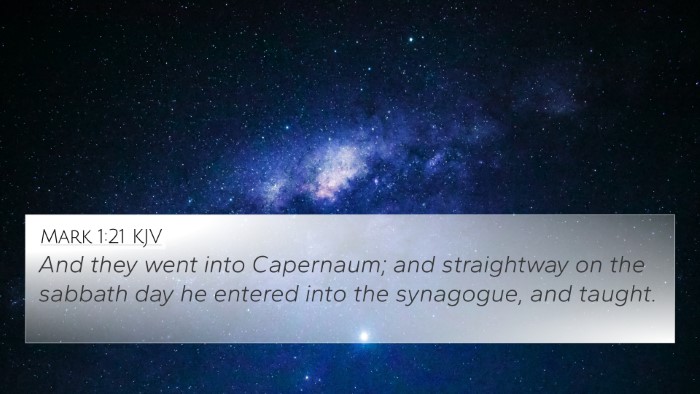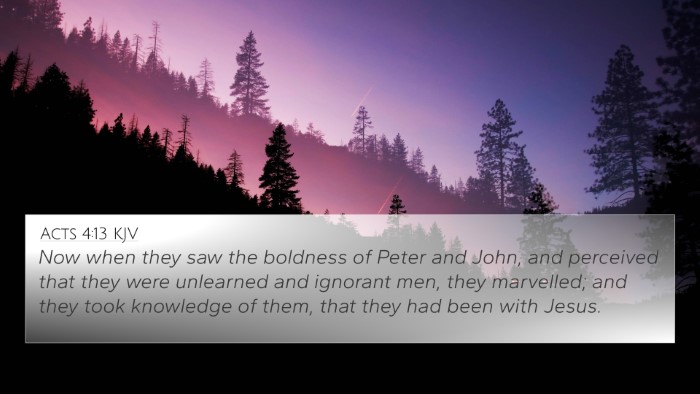Understanding Mark 6:2
Mark 6:2 states:
"And when the sabbath was come, he began to teach in the synagogue: and many hearing him were astonished, saying, From whence hath this man these things? and what wisdom is this which is given unto him, that even such mighty works are wrought by his hands?"
This verse highlights the reaction of the people to Jesus’ teaching and the power of His works, providing a pivotal moment in the ministry of Christ.
Summary of Commentary Insights
-
Matthew Henry's Commentary:
Henry emphasizes the astonishment of the people, pointing out that their familiarity with Jesus as a carpenter's son led to their doubt regarding His authority and wisdom. His teaching in the synagogue on the Sabbath reflects a fulfillment of His Messianic role, despite their skepticism.
-
Albert Barnes' Notes:
Barnes notes that Jesus’ wisdom and the works performed were undeniable, yet the people’s preconceived notions about Him caused them to question His lineage and authority. This illustrates the broader theme of how familiarity can breed contempt, leading to a lack of faith.
-
Adam Clarke's Commentary:
Clarke discusses the significance of the Sabbath and the setting within the synagogue, indicative of traditional Jewish teachings. He expresses that the people’s astonishment was mingled with incredulity, showcasing the tension between Jesus’ divine authority and their earthly expectations.
Key Themes and Insights
Mark 6:2 encapsulates several key themes that are critical for understanding the nature of Jesus’ ministry:
- Recognition of Authority: The verse underscores the confusion of the people as they grapple with recognizing Jesus’ divine wisdom.
- Challenges of Familiarity: It illustrates how knowing someone too well can impede acknowledging their capabilities.
- Divine vs. Earthly Expectations: The verse points towards the tension between the spiritual authority of Christ and the earthly mindset of those He came to save.
Cross-References for Mark 6:2
For deeper biblical understanding, consider exploring the following cross-references:
- Matthew 13:54-58: Reflects a similar response of astonishment and rejection from Jesus’ hometown.
- Luke 4:16-22: Jesus reads from Isaiah in the synagogue, announcing His purpose—this parallels the reception He receives in Mark.
- John 7:15-16: Highlights the amazement of the Jewish leaders at Jesus’ teaching despite His earthly background.
- John 1:46: Nathaniel’s skepticism towards Jesus, questioning, "Can any good thing come out of Nazareth?"
- Luke 6:5: Jesus asserts His Lordship over the Sabbath, showcasing His authority as the Son of Man.
- Acts 3:6-8: Demonstrates the power of Jesus’ name to heal and perform miracles, linking back to might works referenced in Mark.
- 1 Corinthians 1:27-29: God’s choice of the foolish and weak to confound the wise; a principle that resonates with Jesus’ teachings and reception.
Conclusion
The inquiry of "from whence hath this man these things?" illustrates a recurring theme in biblical texts concerning the nature of divine revelation amidst human skepticism. It invites us to consider how we perceive the authority of those familiar to us and challenges us to recognize the sovereign work of God through unexpected vessels.
Additional Resources for Bible Cross-Referencing
To further explore the connections and themes in Scripture, the following tools and methods are beneficial:
- Bible Concordance: A valuable resource for locating specific verses and their contextual relevance.
- Cross-Reference Bible Study: Engage with various verses that interact with your study topic.
- Bible Cross-Reference Guide: Use guides designed to show relationships between verses across various books.
Embracing Inter-Biblical Dialogue
Engaging with Scripture through cross-references enhances your understanding of Biblical narratives. By examining how different verses relate to and inform each other, believers can develop a comprehensive understanding of God's message.











